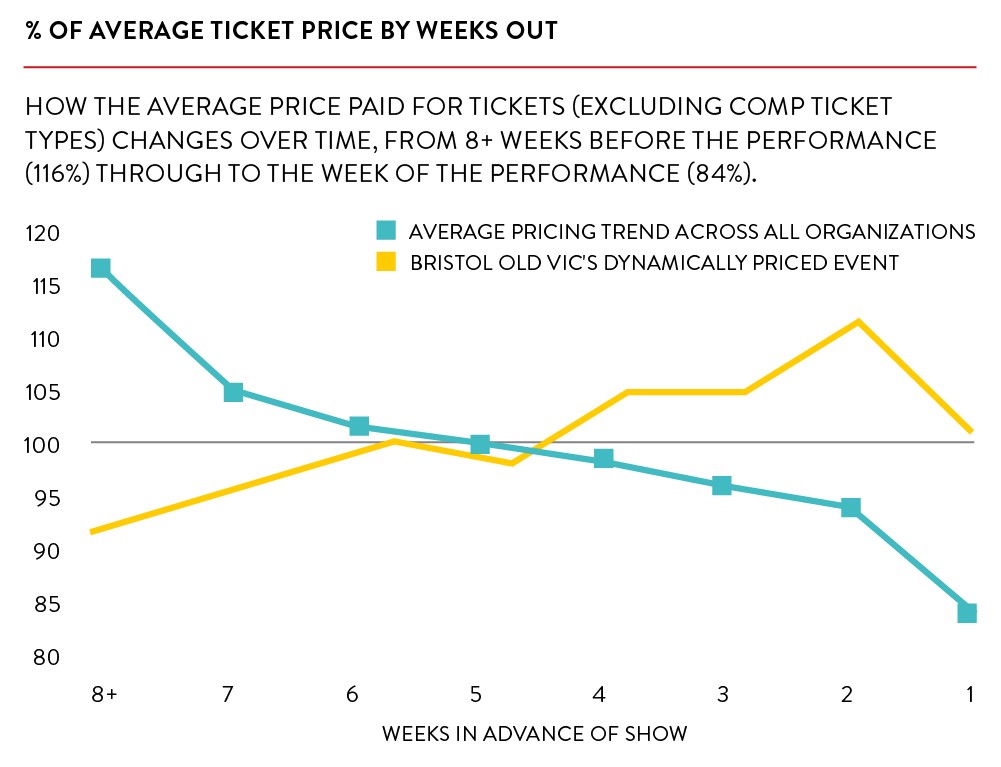7 min read
Set Ticket Prices with Confidence: The Benefits of Dynamic Pricing

In this series, Spektrix demystifies and unpacks the benefits of dynamic pricing for the arts to help leaders make informed decisions.
Think back to the last time you set pricing for an event. Where exactly did that price come from? How cumbersome was the process? And, how responsive was it to the needs of your customers?
Now is a good time to think strategically about how your organization can build confidence in setting prices – dynamic pricing can guide this.
Dynamic pricing utilizes multiple data points to empower users as they set prices. You’ve likely encountered the term in headlines and on the lips of industry colleagues, for better or for worse, with a lot of attention given to a few public examples of how dynamic pricing can be misused. However, customers and arts organizations alike can reap the benefits of dynamic pricing guided by principles of flexibility, trust, and fairness.
At Spektrix, we understand that this topic needs to be approached with care and that it might not be the right approach for every organization. Our priority, as always, is to support the theaters and organizations in our sector – and the best way we can do that is to give you as much information as possible so that you can fully understand the opportunities available to you.
You don’t have to go it alone. Our team is here to advise and facilitate conversations with our dynamic pricing partners and sector experts. So, what is the power of dynamic pricing in the arts? Let’s get the wheels in your head turning on how this strategy could make an impact for your organization.
A dynamic pricing model creates responsiveness and flexibility
The first benefit of dynamic pricing is that it’s, well…dynamic. It changes, it reacts. In this day and age, flexibility, wherever you can find it, is key to adapting to the needs of your audience.
A successful fixed pricing model requires that you make assumptions about audience behavior and accurately predict trends – easier said than done. Audiences have been drastically changing or falling away in the turbulence of recent years, with factors like Covid, the cost-of-living crisis, and lack of funding all playing a role. With so much happening outside your venue’s doors, it can be difficult to benchmark and easy to second guess yourself as you set prices.
“Price tickets too high, and venues remain half-full; too low, and potential revenue is lost. Dynamic pricing automates price adjustments—both up and down—within a set range. This enables swift reactions to demand fluctuations, better sales predictions, and revenue forecasting. The automated nature of dynamic pricing reduces manual interference, yet with human oversight, adjustments can be made swiftly when conditions change unexpectedly.”
— Pal Danyi, PhD, Chief Development Officer, DynamO
Unlike a fixed pricing model, dynamic pricing works when demand isn’t as expected, and even helps create, steer, and predict demand. It can accelerate slow sales, or it can maximize profits for a smash hit. In fact, DynamO reports that adopters of dynamic pricing strategy have seen “immediate revenue growth by 15-20%.”
Instead of stumbling backward from the impact of an unpredicted development, you’re poised on your toes, nimble and ready to move in the right direction.
The right dynamic pricing strategy builds confidence and trust
We’ve all heard horror stories of big-name concert tickets skyrocketing to unfathomable prices. And with the deep relationships felt between arts organizations and their patrons, it’s understandable that conscientious leaders fear exploiting or intimidating their audiences in the same way.
But, as Digonex Director of Marketing Kelly Degenhart puts it, those stories are “the exception, not the rule.” When done with intent, dynamic pricing actually bolsters those customer relationships and supports an audience loyalty model centered on your patrons’ core needs and values.
Good data supports your customers and your team
Your pricing strategy should not be a trust fall – closing your eyes, setting a price, and hoping your customers will respond.
The first step to any truly trusting relationship is paying attention– and in business terms, that means collecting data. One of the most powerful benefits of dynamic pricing in the arts is that it charges you up with information, providing tons of data points and reports for your team to put to use.
When you back your decision-making with real, actionable data, you develop strong reasoning that is mutually beneficial for the needs of you and your customers. You’re better able to understand how your customers behave, who your most loyal base is, and exactly how to tend to their needs.
Craft your ticket pricing strategy with your audience in mind
Just like with any tool in your toolbox, you can make conscious decisions about how you want to use dynamic pricing.
"Box office teams particularly value the pricing strategy feature. It allows them to set a primary objective, whether it's to fill up the seats or optimize revenue, and the pricing adjusts dynamically to align with that goal."
— Bence Marosi, CEO, DynamO
You can, and should:
- Set maximum prices for each of your shows to ensure they never become out-of-hand
- Be proactive about making space for customers who buy at lower price points
- Advertise your price ranges clearly so that customers understand their options
While a dynamic pricing model may be enhanced by technology, it is all still completely within your control.
Take your audience with you on the journey
Communication and transparency are critical. Include explicit information about your pricing policy in your terms and conditions, and don’t hide the price ranges. Meanwhile, make sure your sales and front-of-house teams fully understand the model and can properly explain it when questions arise.
Trust is a muscle. The more you communicate, set expectations, and follow through for your audience, the stronger your relationship will grow.
How to get started with trustworthy dynamic pricing
Be clear about your objectives of dynamic pricing
While revenue enhancement is important to many organizations, many also care just as much about filling seats. Often, the optimal price is a lower price. When we work with clients, we take time to understand the objectives at the performance level and adjust our price recommendations accordingly.
Build in appropriate constraints and controls
This one may seem obvious, but an effective dynamic pricing strategy will set clear constraints and rules such as minimum and maximum price thresholds. We build these types of constraints right into our solution code so that our pricing recommendations are always aligned with our clients’ price range tolerances. We also provide our clients a simple-to-use web portal that allows them to review and approve/reject/override our price recommendations with the click of a button – so the client always maintains visibility and control over the price recommendations before they are sent into the ticketing system and website.
Take a holistic view
It can be tempting to focus disproportionately on only the most obvious opportunities – such as increasing prices on the “premium” seats for a strong-selling performance. In our experience, however, there is a lot to be gained by retaining a holistic view of how you price your house. For example, it is possible to capture the yield opportunity on premium seats while simultaneously retaining a low-price section and optimizing the relative prices across the house to fill it more effectively. Many of our clients also utilize subscriber prices to help set the lower bounds for single tickets to make sure that subscribers always get the best price.
These are a few of the techniques that we utilize to ensure that dynamic pricing generates great outcomes for our clients while also preserving (if not enhancing) the long-term relationship between arts organizations and their patrons.
— Kelly Degenhart, Director of Marketing, Digonex
Dynamic pricing makes your strategy more fair
Maybe you’ve been here before: it’s the week before the show, demand wasn’t what you expected, and you haven’t sold enough tickets. So, you desperately send out a quick promo offer to your email list to try to fill up those empty seats.
This can be an effective band-aid, but when we stop to think about this, is it really fair?
Dynamic pricing opens up the opportunity for savings to everyone from the start, with clear purchase pathways for a greater variety of audience segments. It gives you greater control over the values behind your pricing policies.

Really get to know your audience’s motivations
Your patrons all have different motivations for choosing their tickets and when to buy them, including:
- Financial - They want the cheapest tickets or the best (perceived) price-value ratio
- Experiential - They want to “make a night of it” and love to book the best seats in the house
- Altruistic - They want to support your organization
A fair pricing model caters to all motivations so you can get the value proposition right. But with a fixed pricing model, you can only cater to one small group at a time.
The continuous stream of data you’ll be building with your dynamic pricing partner will provide you with more comprehensive information about your audience and what their individual motivations are. In addition to data directly related to revenue, you’ll take in behavioral metrics as well. From there, you’ll start to discover opportunities.
Some patrons, for instance, love a deal and would take advantage of less expensive tickets – branching out of their usual programming or attending on off-peak nights. Others might always prioritize coming on a weekend or seeing a particular act.
With more of this data in hand, you can reach your audience in a more holistic way. Aim to create incentives for each type of motivation to reward a greater array of your audience.
Reward loyalty and early booking
Early booking and audience loyalty bring major advantages to your organization, creating greater and more predictable revenue. But reactionary price drops can easily undermine those efforts if audiences think that they can receive the best price by holding out.
Let’s go back to our example from above. Ultimately, those drastic last-minute deals wind up penalizing the members of your audience who book early – your most enthusiastic supporters. But with dynamic pricing solutions, you can generate demand and be highly intentional about what behavior provides access to the best price.
You can see it best in this chart provided by Spektrix client Bristol Old Vic, the oldest continuously running theater in the English-speaking world and a hotspot for cutting-edge theatre. The theater began its dynamic pricing strategy in 2018 and immediately saw results.

In the blue line depicting average pricing across all organizations, you see that as time progresses and discounts roll out, the price of tickets is going down – meaning that the earliest bookers are receiving the highest price.
With Bristol Old Vic’s dynamic pricing model in yellow, we see that the cost is increasing with time. By setting their pricing strategy this way, they’re ensuring that their audiences are not getting penalized for the good behavior of booking early.
Your customers will understand this too. Think about booking a plane ticket. If you book your flight the night before, you probably would expect to pay more because you’re booking at the last minute.
When patrons know that they can consistently get the best price by booking early, you’ll shape their behavior and drive up demand – all while supporting those early bookers in kind.
Plus, as we continue to think about audience motivations, you can start to see where dynamic pricing overlaps with other loyalty models, especially as you throw altruistic motivations into the mix. Having the data to understand your customers’ motivations is key to subscriptions, memberships, pay-what-you-can, or other flexible pricing models. Once again, you have more control over how your organization’s values are reflected within your pricing policies.
Unlocking the benefits of dynamic pricing
Dynamic pricing can be a solution for benchmarking prices and growing confidence in setting prices. It supports theaters and arts organizations by helping you to understand your audience better and build an impactful audience loyalty strategy.
Now that you understand the benefits of dynamic pricing, you’re ready to dig in a little deeper to determine if it's the right fit for your organization and how to implement it. Spektrix and our partners are here for consultation and advice. Let’s continue this conversation.
Tom Nolan (he/him) is the Head of Global Ecosystem at Spektrix.



